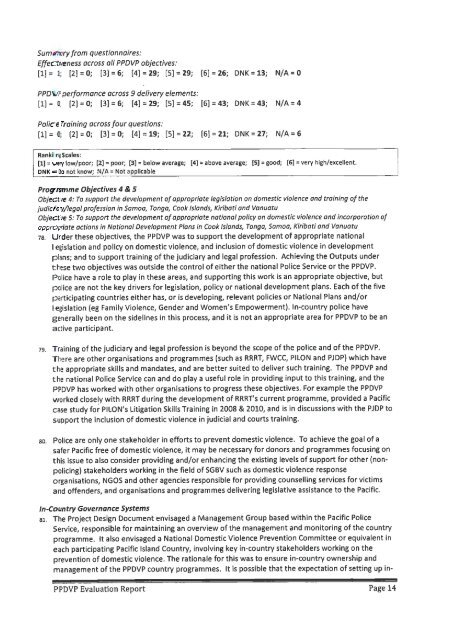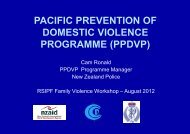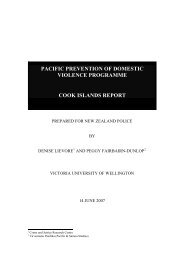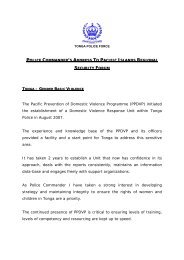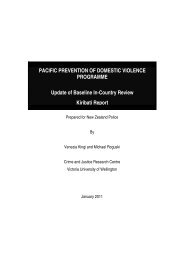PPDVP Evaluation Report - Pacific Prevention of Domestic Violence ...
PPDVP Evaluation Report - Pacific Prevention of Domestic Violence ...
PPDVP Evaluation Report - Pacific Prevention of Domestic Violence ...
Create successful ePaper yourself
Turn your PDF publications into a flip-book with our unique Google optimized e-Paper software.
Summy from questionnaires:Effectrveness ocross all <strong>PPDVP</strong> objectives:[I] = 1; [2] = 0; [3] = 6; [4] = 29; [5] = 29; [6] = 26; DNK = 13; N/A = 0PPDWP performance across 9 delivery elements:[I] = 0; [2] = 0; [3] = 6; [4] = 29; [5] = 45; [6] = 43; DNK = 43; N/A = 4Police Training across four questions:[I] = 0; [2] = 0; [3] = 0; [4] = 19; [5] = 22; [6] = 21; DNK = 27; N/A = 6Ranki ng Scales:(1) = vev low/poor; 121 = poor; [3] = below average; 141 = above average; 151 = good; [6] = very high/excellent.DNK = Do not know; N/A = Not applicableProgramme Objectives 4 & 5ObjecBve 4: To support the development <strong>of</strong> appropriate legislation on domestic violence and training <strong>of</strong> thejudiciory/legal pr<strong>of</strong>ession in Samoa, Tonga, Cook Islands, Kiribati and VanuatuObjective 5: To support the development <strong>of</strong> appropriate national policy on domestic violence and incorporation <strong>of</strong>appropriate actions in Notional Development Plans in Cook Islands, Tonga, Samoa, Kiribati and Vonuatu78. Under these objectives, the <strong>PPDVP</strong> was to support the development <strong>of</strong> appropriate nationalI egislation and policy on domestic violence, and inclusion <strong>of</strong> domestic violence in developmentplans; and to support training <strong>of</strong> the judiciary and legal pr<strong>of</strong>ession. Achieving the Outputs underthese two objectives was outside the control <strong>of</strong> either the national Police Service or the <strong>PPDVP</strong>.Police have a role to play in these areas, and supporting this work is an appropriate objective, butpolice are not the key drivers for legislation, policy or national development plans. Each <strong>of</strong> the fiveparticipating countries either has, or is developing, relevant policies or National Plans and/orlegislation (eg Family <strong>Violence</strong>, Gender and Women's Empowerment). In-country police havegenerally been on the sidelines in this process, and it is not an appropriate area for <strong>PPDVP</strong> to be anactive participant.79. Training <strong>of</strong> the judiciary and legal pr<strong>of</strong>ession is beyond the scope <strong>of</strong> the police and <strong>of</strong> the <strong>PPDVP</strong>.There are other organisations and programmes (such as RRRT, FWCC, PlLON and PJDP) which havethe appropriate skills and mandates, and are better suited to deliver such training. The <strong>PPDVP</strong> andthe national Police Service can and do play a useful role in providing input to this training, and the<strong>PPDVP</strong> has worked with other organisations to progress these objectives. For example the <strong>PPDVP</strong>worked closely with RRRT during the development <strong>of</strong> RRRT's current programme, provided a <strong>Pacific</strong>case study fo; PILON's Litigation Skills Training in 2008 & 2010, and is in discussions with the PJOP tosupport the inclusion <strong>of</strong> domestic violence in judicial and courts training.so.Police are only one stakeholder in efforts to prevent domestic violence. To achieve the goal <strong>of</strong> asafer <strong>Pacific</strong> free <strong>of</strong> domestic violence, it may be necessary for donors and programmes focusing onthis issue to also consider providing and/or enhancing the existing levels <strong>of</strong> support for other (nonpolicing)stakeholders working in the field <strong>of</strong> SGBV such as domestic violence responseorganisations, NGOS and other agencies responsible for providing counselling services for victimsand <strong>of</strong>fenders, and organisations and programmes delivering legislative assistance to the <strong>Pacific</strong>.In-Country Governance Systemsal. The Project Design Document envisaged a Management Group based within the <strong>Pacific</strong> PoliceService, responsible for maintaining an overview <strong>of</strong> the management and monitoring <strong>of</strong> the countryprogramme. It also envisaged a National <strong>Domestic</strong> <strong>Violence</strong> <strong>Prevention</strong> Committee or equivalent ineach participating <strong>Pacific</strong> Island Country, involving key in-country stakeholders working on theprevention <strong>of</strong> domestic violence. The rationale for this was to ensure in-country ownership andmanagement <strong>of</strong> the <strong>PPDVP</strong> country programmes. It is possible that the expectation <strong>of</strong> setting up in-- .-<strong>PPDVP</strong> <strong>Evaluation</strong> <strong>Report</strong> Page 14


